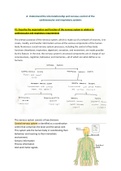Essay
Unit 9: Human Regulation and Reproduction - Learning aim A
- Course
- Institution
Unit 9: Human Regulation and Reproduction A: Understand the interrelationship and nervous control of the cardiovascular and respiratory systems. Contains: P1: Assess the role of the nervous system in coordinating the cardiovascular and respiratory systems M1: Explain how nervous impulses are...
[Show more]



